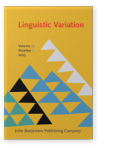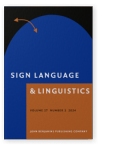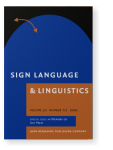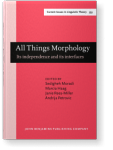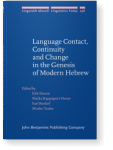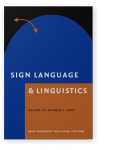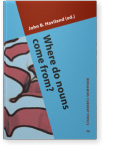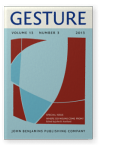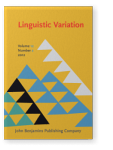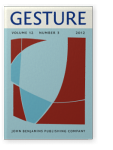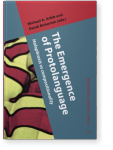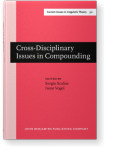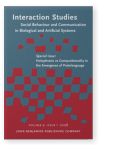Wendy Sandler
List of John Benjamins publications for which Wendy Sandler plays a role.
Journals
ISSN 1387-9316 | E-ISSN 1569-996X
Title
Special Issue in Memory of Irit Meir
Edited by Diane Lillo-Martin, Wendy Sandler, Marie Coppola and Rose Stamp
Special issue of Sign Language & Linguistics 23:1/2 (2020) vi, 285 pp.
Subjects Electronic/Multimedia Products | Signed languages | Theoretical linguistics
2021 Chapter 4. Signs and words All Things Morphology: Its independence and its interfaces, Moradi, Sedigheh, Marcia Haag, Janie Rees-Miller and Andrija Petrovic (eds.), pp. 57–80 | Chapter
Natural sign languages both constrain and expand our understanding of the nature of words. In each modality, words can be used in isolation, have meanings or grammatical functions, and are identifiable by their prosodic form. Such shared properties constrain the universal definition of the word.… read more
2020 Visual foreign accent in an emerging sign language Special Issue in Memory of Irit Meir, Lillo-Martin, Diane, Wendy Sandler, Marie Coppola and Rose Stamp (eds.), pp. 233–257 | Article
In the study of sign language phonology, little attention has been paid to the phonetic detail that distinguishes one sign language from another. We approach this issue by studying the foreign accent of signers of a young sign language – Al-Sayyid Bedouin Sign Language (ABSL) – which is in… read more
2020 Irit Meir: Introduction to the special issue Special Issue in Memory of Irit Meir, Lillo-Martin, Diane, Wendy Sandler, Marie Coppola and Rose Stamp (eds.), pp. 1–16 | Introduction
2019 Variation and conventionalization in language emergence: The case of two young sign language of Israel Language Contact, Continuity and Change in the Genesis of Modern Hebrew, Doron, Edit, Malka Rappaport Hovav, Yael Reshef and Moshe Taube (eds.), pp. 337–364 | Chapter
Languages are constantly formed and changed by the opposing forces of variation and conventionalization. Yet it is not clear whether one of the two forces is prior to the other in language emergence, nor do we know how the two interact early in the life of a language. By comparing two young sign… read more
2016 Taking meaning in hand: Iconic motivations in two-handed signs Sign Language & Linguistics 19:1, pp. 37–81 | Article
Traditionally in sign language research, the issue of whether a lexical sign is articulated with one hand or two has been treated as a strictly phonological matter. We argue that accounting for two-handed signs also requires considering meaning as a motivating factor. We report results from a… read more
2015 The noun-verb distinction in two young sign languages Where do nouns come from?, Haviland, John B. (ed.), pp. 9–41 | Article
Many sign languages have semantically related noun-verb pairs, such as ‘hairbrush/brush-hair’, which are similar in form due to iconicity. Researchers studying this phenomenon in sign languages have found that the two are distinguished by subtle differences, for example, in type of movement. Here… read more
2013 The noun–verb distinction in two young sign languages Where do nouns come from?, Haviland, John B. (ed.), pp. 253–286 | Article
Many sign languages have semantically related noun-verb pairs, such as ‘hairbrush/brush-hair’, which are similar in form due to iconicity. Researchers studying this phenomenon in sign languages have found that the two are distinguished by subtle differences, for example, in type of movement. Here… read more
2012 The influence of community on language structure: Evidence from two young sign languages Linguistic Variation 12:2, pp. 247–291 | Article
By comparing two sign languages of approximately the same age but which arose and developed under different social circumstances, we are able to identify possible relationships between social factors and language structure. We argue that two structural properties of these languages are related to… read more
2012 Dedicated gestures and the emergence of sign language Gesture 12:3, pp. 265–307 | Article
Sign languages make use of the two hands, facial features, the head, and the body to produce multifaceted gestures that are dedicated for linguistic functions. In a newly emerging sign language — Al-Sayyid Bedouin Sign Language — the appearance of dedicated gestures in signers of four age groups… read more
2010 The roots of linguistic organization in a new language The Emergence of Protolanguage: Holophrasis vs compositionality, Arbib, Michael A. and Derek Bickerton (eds.), pp. 133–152 | Article
It is possible for a language to emerge with no direct linguistic history or outside linguistic influence. Al-Sayyid Bedouin Sign Language (ABSL) arose about 70 years ago in a small, insular community with a high incidence of profound prelingual neurosensory deafness. In ABSL, we have been able to… read more
2010 Sign languages and compounding Cross-Disciplinary Issues in Compounding, Scalise, Sergio and Irene Vogel (eds.), pp. 301–322 | Article
Compounding is one of the few sequential word formation processes found across sign languages. We explore familiar properties of compounds in established sign languages like American Sign Language, as well as a modality-specific type of simultaneous compounding, in which each hand contributes a… read more
2008 The roots of linguistic organization in a new language Holophrasis vs Compositionality in the Emergence of Protolanguage, Arbib, Michael A. and Derek Bickerton (eds.), pp. 133–153 | Article
It is possible for a language to emerge with no direct linguistic history or outside linguistic influence. Al-Sayyid Bedouin Sign Language (ABSL) arose about 70 years ago in a small, insular community with a high incidence of profound prelingual neurosensory deafness. In ABSL, we have been able to… read more
1999 Cilticization and Prosodic Words in a Sign Language Studies on the Phonological Word, Hall, Tracy Alan and Ursula Kleinhenz (eds.), pp. 223–254 | Article
1999 The Medium and the Message: Prosodic Interpretation of Linguistic Content in Israeli Sign Language Sign Language & Linguistics 2:2, pp. 187–215 | Article
In natural communication, the medium through which language is transmitted plays an important and systematic role. Sentences are broken up rhythmically into chunks; certain elements receive special stress; and, in spoken language, intonational tunes are superimposed onto these chunks in particular… read more
